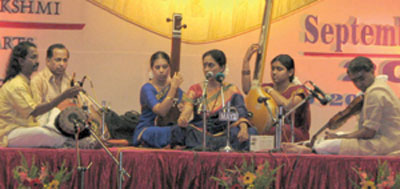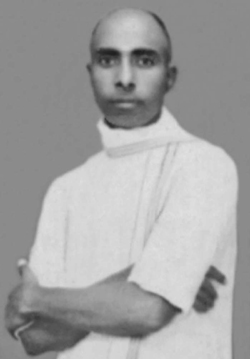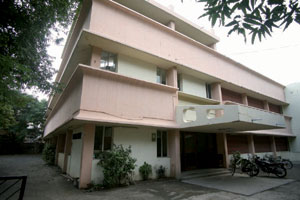NEWS & NOTES

It rains music in Coimbatore
B. RAMADEVI
Rajalakshmi Fine Arts was started in Coimbatore by Dr. Satish Kumar in 2002 to perpetuate the memory of his mother Rajalakshmi, a fine arts person. Music and surgery are strange bedfellows, but Dr. Satish Kumar is passionate about both. He is a full time surgeon who goes all out to learn more about music and share it with the members of his sabha. In five years, the sabha has grown in size, stature and prestige. It has been inviting popular artists in the field of Carnatic music. After Rajalakshmi programmes, even those who do not know anything about music usually go home with a little knowledge about the kriti-s and composers. Dr. Satish Kumar asks interesting questions, provides relevant information and keeps communicating with his members through the LCD screen and gets them interested.
Artists enjoy performing here because the doctor, a student of music (Western earlier, Carnatic now) gives challenging themes to inspire the musicians to do intense research and come out with new gems every year. Year after year, the September Season is improving in quality. There are vocal and instrumental Carnatic music concerts, Bharatanatyam recitals, lecture demonstrations and musical discourses. There is a slot for young talent too. Every year, on the anniversary of the sabha’s inauguration, a deserving artist is honoured with the title, ‘Isai Mani Makutam’ or ‘Natya Mani Makutam’ depending on the field in which that person has made his or her contribution. Bombay Jayashri Ramnath, Nithyasree Mahadevan, K. Omanakutty, K.J. Sarasa and Rama Ravi have been the recipients of this honour so far. The Sabha awarded the title Sangeeta Sagara Ratna to D.K. Pattammal in 2003, and, for Brinda-Muktha, to Mukthamma in 2004. Dr. Satish Kumar went to Mukthamma’s house and handed it to her in person.
The sabha conducted concerts throughout the night for Sivaratri for two consecutive years. Carnatic music is taught to students with a real love for it. The sabha arranges for the sale of books connected with music and initiate and maintain a mood of melody throughout the season.
This year, the September Season (5th Annual Music Festival) began on the first of September with a Bharatanatyam recital by Divyatha Arun, a disciple of K.J. Sarasa. This was followed by N. Vijay Siva’s inaugural concert. His traditional rendering was both impressive and enjoyable.
As ‘Sagara Sayana’ was Bombay Jayashri Ramnath’s theme, most of the kriti-s she sang were on Vishnu. Her Parimala Ranganatham (Hameer Kalyani, Dikshitar) Ksheerasagara sayana (Devagandhari, Tyagaraja) and Sagarasayana vibho (Bagesree, M.D. Ramanathan) were appropriate and pleasant. The RTP in Charukesi, with the pallavi ‘Muthukkalo kangal, titippatho kannam, paarkkadal urainthidum mannaa’, in Khanda Triputa tala stole the show. Without sparkles, thrills or frills, she succeeded in creating the effect of melting devotion.
COVER STORY

Palghat R. Raghu Dedicated mridanga vidwan
Vijayalakshmy Subramaniam
Mridanga vidwan Palghat Raghu will receive the prestigious title of Sangeeta Kalanidhi conferred by the Music Academy at its Sadas to be held on 1st January 2008 in Chennai. Carnatic musician VIJAYALAKSHMY SUBRAMANIAM presents a comprehensive feature for Sruti comprising a profile, interview and tributes to the maestro.
“My first concert was at the age of twelve, when I accompanied Papanasam Sivan at the residence of Kothamangalam Subbu in Mylapore in 1940. We had recently moved to Madras following declaration of the Second World War in 1939.” This was the beginning of an illustrious and memorable career for one of the leading mridanga vidwans of our time, Sangeeta Kalanidhi designate 2008, Palghat R. Raghu.
Raghu always knew he wanted to be a mridanga vidwan. His life story has a slightly different beginning from those of most other musicians. He was born in Burma on January 9th 1928. His father Ramaswamy was a government employee. Raghu inherited much of his music from his mother Ananthalakshmi and his aunt, both very good singers. His mother was his initial source of inspiration. His grandfather Radhakrishna Iyer, a highly respected figure in Burma, was an authority of sorts on Carnatic music. Raghu began his early training under one Swamy at Rangoon. However, it was the visit of Thinniam Venkatarama Iyer to Burma that brought a sharp focus to the boy’s talents. At the end of a ‘crash course’ under Venkatarama Iyer for about twentyone days, the teacher was impressed with his pupil. He offered to teach him during his visits to Madras. With war impending, the family had to relocate to Madras and soon Raghu came under his tutelage. The lessons were about a year old when fate intervened again. The family moved to Palghat in 1940 — as part of the war time evacuation of Madras — so that Raghu could undergo training with the stalwart, Palghat Mani Iyer. It is interesting to note that Raghu had no other connection to Palghat. His family belonged to Trissoor.
The initial lessons with Mani Iyer saw the maestro focusing on Raghu’s fingering techniques and making changes to suit his style of play. Thus began a long association that went on to make Raghu his foremost disciple. To quote Raghu, “I had heard the mahavidwan play and was dumbstruck at his abilities. His playing was so fascinating, I used to wonder if he was really human or divine? Was it possible for a human being to play the way this vidwan did? It was, for me, a dream come true. Being Mani Iyer’s disciple was like being a member of his family. He went for a walk every morning and I accompanied him, walking just a bit behind him.
He discussed various aspects of laya and also quizzed me on what I had been doing. I then told him about the ‘korvai’ or ‘kanakku’ that I was working on and he listened very intently. He was always encouraging and wanted me to learn more by listening than from actual one to one teaching. Mani Iyer was of the opinion that a mridanga vidwan must know vocal music and a vocalist mridanga. Palghat K.V. Narayanaswamy came for practice around this time and I used to accompany him often.”
SPECIAL FEATURE

R.K. Venkatarama Sastry - A true devotee of sangeetam
V. RAMNARAYAN
There is a school of thought that to be a great Carnatic musician, you need to be blessed with the serendipity of being born on the banks of the Kaveri in a pious family leading an austere lifestyle in the vicinity of a temple. A staple of vadu mangai and buttermilk and pazhaiyathu, or their Karnataka equivalent if you happened to wet your feet in the river closer to its origins, would help too, not to mention a strict regimen of sandhyavandanam three times a day.
By all accounts, musician, Harikatha artist, playwright and Sanskrit and Kannada scholar Rudrapatnam Krishna Sastry, who married singer Sannakka, daughter of vainika-violinist Bettadapura Narayanaswamy, in the early years of the 20th century, enjoyed just such a concatenation of circumstances. His first son, Rudrapatnam Krishna Venkatarama Sastry, was born on November 10th 1907 at Rudrapatnam, a stone’s throw from the waters of the sacred river. Venkatarama Sastry — whose birth centenary celebrations begin from 11th November 2007 with a music festival in Chennai — showed early signs of musical talent which his father nourished by exposing him to the best available training with distinguished guru-s.
(This Sanketi family from the Hassan district of Karnataka went on to produce some nine more musicians at last count. For a detailed account, see the R.K. Srikantan profile in Sruti 134, November 1995). After spending more than a decade learning violin from Veena Subbanna and Mysore T. Chowdiah, he moved to Madras in 1936, to join All India Radio when it was formed.
MAIN FEATURE

The Indian Fine Arts Society - The Saga of a Sabha
SRIRAM.V
The Indian Fine Arts Society (IFAS) turned 75 this year, but the founding day, 14th January, passed unnoticed. The annual music festival and conference this year also promise to be characteristically low-key and dignified. This is a result of modesty as much as circumstances, but there was a time when the IFAS appeared to pose a serious threat to the Music Academy.
Tradition has it that the IFAS was founded by a few Telugu-speakers of Madras city to fight the tyranny of Tanjavur Tamil at the Music Academy. The moving spirits behind the new sabha however were T. Chowdiah, the eminent violinist and B.V. Gopalakrishna Rao, an employee of the Madras Corporation. The sabha was inaugurated by Sir M. Venkatasubba Rao, Judge of the Madras High Court, on 14th January 1932. The inauguration was perhaps a low key affair for it does not find mention in the popular press of the day. The registered office of the Sabha was in a building opposite what is today Telephone House on N.S.C. Bose Road.
Right from the beginning, the Telugu-speaking Vaisya community, comprising the Komutti and Beri Chettys of George Town became ardent patrons (see article titled The Musical Chettys of Chennai). Foremost among these were Chinna Yelamanda Anjaneyulu Chetty, iron merchant of Kanniah and Sons, Nainiappa Naicken Street, George Town and Addanki Varadappa Chetty of Acharappan Street, George Town. C.Y. Anjaneyulu Chetty was, in particular, a great patron of the arts, and his palatial home in Kilpauk, Llanstephan, was the venue for music concerts. Yet another livewire was T.V. Subba Rao, a manager at the V. Perumal Chetty led business house of Hoe and Company, not to be confused with T.V. Subba Rao, the Jagirdar of Aska who was closely associated with the Music Academy and was the first President of its Annual Conference.


